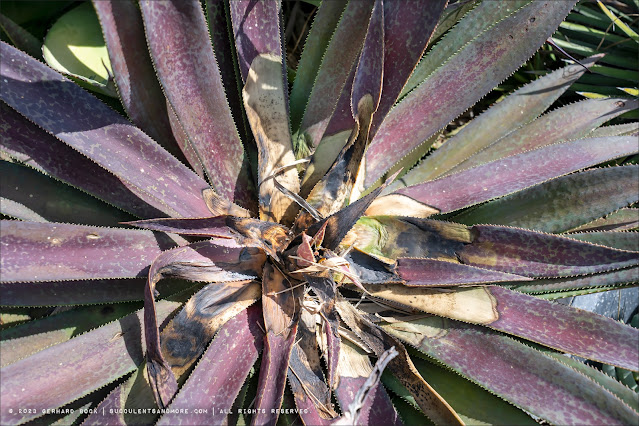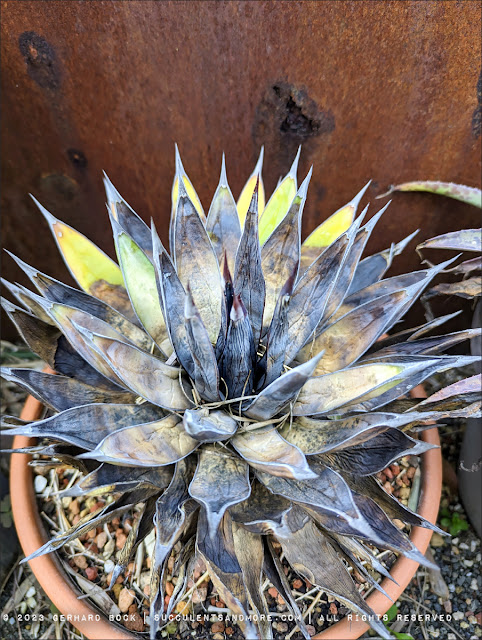I’ve been putting this off long enough, but now it’s time to face the music. I need to preface this post with a warning: Viewing these photos might be detrimental to your mental health.
In California, this winter has been one for the record books, both in terms of snowfall in the mountains and rain elsewhere. Since the beginning of the 2023 water year on October 1, 2022, Davis has had 32 inches of rain. That’s almost twice of what we had in 2022, and three times the amount of 2021. In January and even in February, it was still easy to cling to the mantra “rainisgoodrainsigoodrainisgood,” but that became harder to do as one atmospheric river after another barreled through. (According to the National Weather Service, California was hit by 14 atmospheric rivers this winter, although two were fairly weak).
Needless to say, this much precipitation did significant damage to many succulents in our garden; they’re simply not equipped to handle extended periods of cold and wet. While some—the majority even—came through relatively unscathed, others succumbed to the inevitable rot.
I wish I could draw any meaningful lessons from this, but as you can see below, there’s no clear pattern to what did poorly and what did well. Since it’s hard to learn from randomness, I’m focusing on the overall picture, which is actually pretty decent. (See, I’m trying to be optimistic!)
With that in mind, let’s dive in. For each plant, I’ll indicate whether I kept it in hopes of it making a comeback or whether I removed it.
 |
| Mangave ‘Bad Hair Day’ is having a permanently bad hair day [REMOVED] |
I lost quite a few mangaves. They appeared to hold up for a while, but eventually they turned to mush.
 |
| Mangave ‘Bloodlines’ on March 17. I still had some hope it might pull through (I’d repeatedly drenched the center with fungicide). |
 |
| But on March 25, it became clear it was a goner. When I removed it, I found two tiny offsets; with any luck, one of them will survive. [REMOVED] |
 |
| Mangave ‘Lavender Lady’ did remarkably well until last week when I noticed this. I’m not liking the way these leaves are folding down. [KEPT] |
 |
| Grevillea ‘King’s Celebration’ had grown to 7 ft. and was covered with buds. But it got so battered in the many wind storms we had that I decided to remove it. It was getting too large for this tight spot anyway. [REMOVED] |
 |
| Grevillea ‘King’s Celebration’ gone |
 |
| Acacia cognata ‘Cousin Itt’ didn’t have any winter damage per se, but keeping it looking neat in this spot next to the sidewalk was getting difficult, so I made the difficult decision to remove it. [REMOVED] |
 |
| In the spot where ‘Cousin Itt’ had been, I created a small cactus mound with three Echinocereus rigidissimus var. rubrispinus and several other tiny cacti. It isn’t quite finished yet (top dressing still to come), but I think it’s a more appropriate choice of plants. |
Last weekend, I replanted the area where I’d removed Aloe lavranosii, Mangave ‘Blazing Saddles’, Agave ovatifolia ‘Killer’, and Agave ‘Chisum’. There are three new agaves (Agave potatorum ‘Spawn’ × A. isthmensis, Agave shawii × isthmensis, Agave margaretae), a new Dudleya traskiae, and several new cacti (Mammillaria wrightii, Mammillaria gracilis, two Coryphantha retusa, two white-spined Echinocereus rigidissimus and another Echinocereus rigidissimus var. rubrispinus. There’s still room for smaller plants to be tucked in here and there—and the top dressing is still missing.
Since I’m making so many major changes, I’m also considering removing our Agave vilmoriniana ‘Stained Glass’:
It looked far more graceful when it was young. Now it’s just a tangle of leaves, with the tips permanently shriveled up. I think it’s time to give it the chop and plant something else. Change is good, right?
© Gerhard Bock, 2023. All rights reserved. To receive all new posts by email, please subscribe here.




























This post warrants more than an "Ugh" or "I'm sorry" but I can't think of anything more articulate to say after reviewing your losses. And you're right, it's hard to take away lessons from the experience when there's no pattern to our rainfall. You got 11 inches more rain than I did. I also credit my sandy soil as another factor in my favor. Maybe some of your more expensive and hard to find specimens would be safer in pots that you can move under a cover of some kind if El Nino is in the forecast for the next water year?
ReplyDeleteIf I had known how much rain we were going to get, I would have tried to rig up some sort of rain cover. But I do believe this is a once-in-a-generation event, and we really can't plan for extremes.
DeleteGerhard, that's a lot of losses. I'm sorry your drought has broken (has it?) with such a destructive series of rain events. Ugh. I admire how you're taking it in stride and making the always challenging decision to remove plants look easy. I hope the new plantings bring you renewed joy in your garden.
ReplyDeleteFor a while, I tried to ignore the carnage, but now I've accepted it and see it as an opportunity to change things up. That DOES bring me a measure of joy that had been missing recently.
DeleteI think once again I typed a comment and neglected to click PUBLISH. Or did I? Sorry if this is a duplicate.
ReplyDelete32"--quite amazing. Cold+32" = rot. Here 23" and not so cold was enough to squeak by.
The ovatifolia is the big loss. Owie and yikes. Thinking of plant losses as knowledge gained and earned--that gets me past the loss faster.
I had bought another of the 'King's' Grevilleas--last year--pulled it out a few days back--that will be the last of those--it had no root system to speak of. Will stick to 'Superb's now.
I forget to click Publish, too, sometimes. Now I copy my reply so I can paste it back in if needed.
DeleteSeeing how big this grevillea was, it really shouldn't have been that wobbly! You're right, they don't seem to have very robust root systems.
Well, I'm impressed how you documented the destruction. I'm avoiding even thinking about it. I had the same experience with various mangaves, they just couldn't deal with the wet. The ovatifolia loss is a total bummer. I love that you removed the grevillea (at first I admit I thought nooooo). The raised cactus bed is fabulous, love how you added the rocks! Your garden looks great, if I was walking by I would not know you lost a thing.
ReplyDeleteYour last sentence ("if I was walking by I would not know you lost a thing") made my day. That's what I'm aiming for.
DeleteI'm still surprised that so many mangaves couldn't cope with the rain...
The randomness... it's hard isn't it? Our gardening brains want to find a reason, learn from it so we can avoid it in the future. I am facing the same random pattern to the damage and death. The demise of your Agave ovatifolia ‘Killer’ is so sad, such a beauty! The state of the mangaves is why I am always hesitant when I see someone plant them here, they just can't handle cold and wet. I'm working on a similar post for next week. I need to track just how bad this winter was for my own self...
ReplyDeleteThe randomness *is* the hardest part. In hindsight, I should have been more proactive, rigging up some sort of rain protection. But in all honesty, I never expected THIS much rain, for so long.
DeleteI like the changes you have made, mostly because Agaves are not my favorite plants. I love the replacements. Let's hope winter 2023 will be much gentler for you and your garden.You unfortunately got the majority of the rain, but we got a nice amount to make happy plants here in Phoenix. My cactus are budded and blooming like crazy. I would be happy if every winter was like this one! It all depends on so many factors!
ReplyDeleteI take some (grim) comfort from the fact that many gardens lost agaves, cacti, aloes, etc. not just here but in Southern California as well. There's only so much we can do.
DeleteI'm blown away by the amount of cactus flowers you have in your garden already!
You lost some beauties for sure, Gerhard. Sincerest condolences. I'll probably be doing a damage report on my zone 10 garden soon too after I have a quick look around this April. And I know you amended and lightened and mounded your soil way more than I did! Here in coastal Oregon I left Mangave 'Whale Tale' in a pot outside all winter and the center is still solid -- slightly under an eave and protected by a stock tank fwiw.
ReplyDeleteGreat to hear about your 'Whale Tale'. With Agave ovatfolia genes, it's definitely one of the hardier mangaves.
DeleteI've amended the soil a lot, and as far as I can tell, the rot always starts at the top (typically in the crown) vs. coming from the ground.
Sad and discouraging. There's the old addage where 'when something dies it's just an opportunity to plant something new' but this goes way beyond that. I admire your efforts to remain upbeat. Think I might just have cried. Mother Nature can be so cruel. Hopefully the remainder heal and pull through.
ReplyDeleteI keep going back and forth between a self-indulgent pity party and looking at the big picture: the water situation in California is SOOOOOO much better than it has been in years!
DeleteIt was so sad to see all the plants that suffered from that much rain you had. It was just painful to see, but you took matters in hand and did what you had to do. And now new plantings will make it all beautiful again.
ReplyDeleteMy garden mangave look the same! But you have given me the courage to pull them out. I was dreading it.
ReplyDelete